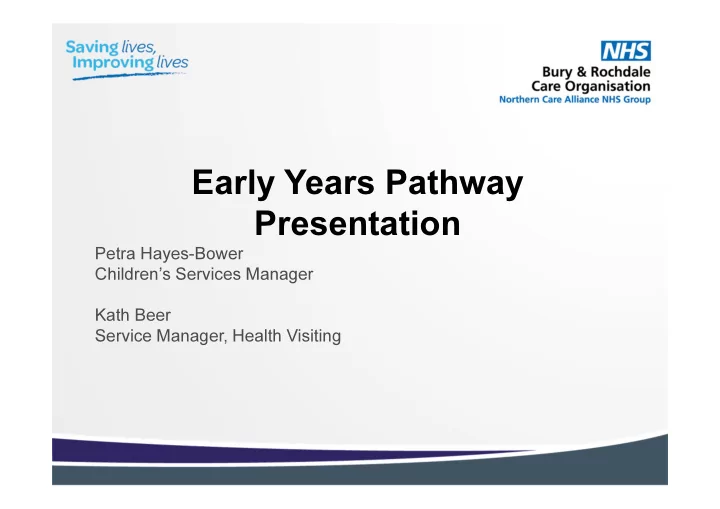

Early Years Pathway Presentation Petra Hayes-Bower Children’s Services Manager Kath Beer Service Manager, Health Visiting
Why a new model? To combine Family Nurse Partnership (FNP) and Health Visiting (HV) experience in one team to improve the outcomes for all Bury Children and families To work in all age township model to support person centred care neighbourhood approach To look beyond health teams to understand inter-agency working Successfully delivered new working model with school nursing
Support for Complex Families Drawing on experience from FNP role Use of FNP tools (unlicensed) Integrate this specialist role into mainstream HV to provide peer support and share specialist knowledge
Aim of the new model The aim of the revised delivery model is to improve the health and wellbeing of children and young people by responding to identified health needs based on robust public health and evidenced based data To learn lessons from FNP programme and ensure the added value is transferred into the new Early Years model and the Health Visiting service
Neighbourhood Teams • Provides a local service that meets the needs of that neighbourhood • Provides support and care to client / families in a co-ordinated way, with the client at the centre of planning their own care • A number of agencies within that neighbourhood work in partnership to ensure the right care and support is provided to that individual / family. Reduce duplications, clients not having to re-tell their story • Agencies will share best practice / education etc • Working smarter not harder - efficiencies
AGMA Delivey Model • Provides a core integrated set of engagement points that all agencies can use to track a child’s progress pre-birth – 5 years • Integrated – no duplication, therefore more cost effective • Progressive, not repetitive • Identifies additional needs at earliest opportunity
AGMA Delivery Model • Enables comparisons, contracts and impact across GM • Supports shared outcomes • Uses the child’s NHS number as unique and consistent identification • Assessments aligned with agreed GM Early Years Outcomes Framework • A common consistent assessment took to be used
Partnership working – next steps Regular MDT meetings with • Integrated Neighbourhood teams • Bury Parents Forum • Children’s Centres
What outcomes will be new model achieve? To have a fit for purpose universal offer for our youngest children 0 – 5 years and their families. Based on progressive universalism Delivery is to be rooted in Neighbourhoods and embedding a integrated approach across agencies, providing responsive effective support The new model will have at its heart the vision for children, families and communities to be independent, resilient and self-caring. In line with our early Years Strategy.
On going developments • Pilot site for GM digitalisation od ASQ • Focus on the 1001 critical days and integrated working with GM, Public Health and Local Authority • Perinatal Infant mental Health- Introduction of NBO, NBAS • Introduction of Wellcomm • UNICEF accreditation • SEND- Integrated Health Visitor post within the learning disability team
Any questions
Recommend
More recommend